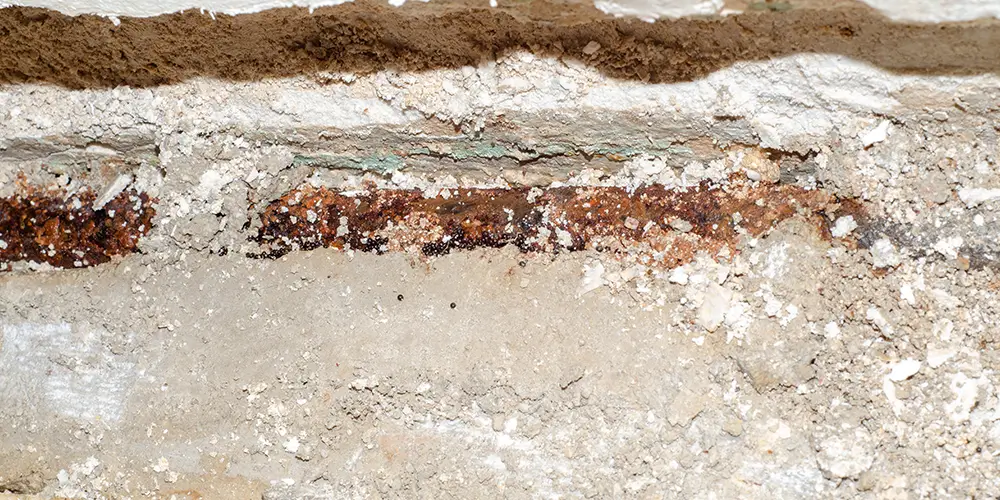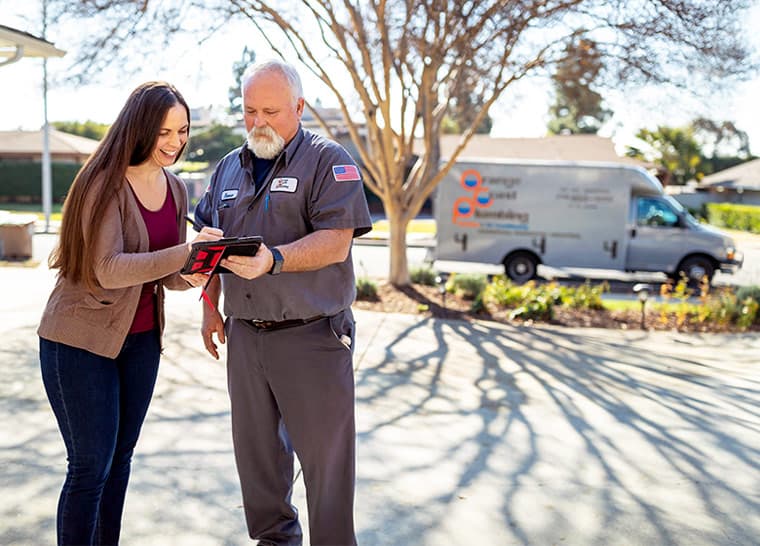No leak is a good leak. But some leaks are an annoyance and minor expense; others are category-five disasters.
If a faucet leak is a fender bender, a slab leak is a full-on 50-vehicle freeway pileup — or has the potential to be unless you detect and repair it early. It can place your health at risk and damage your home beyond repair.
Slab Leak Definition
Most Southern California homes and businesses are built on concrete foundations or “slabs.” Water and sewer pipes run through the foundations unnoticed unless something goes wrong.
That “something” is often a slab leak in or under a building’s concrete slab foundation.
- Slab leaks are difficult to detect.
- Slab leaks are difficult to repair (although new technologies make the job easier).
- Slab leaks can completely undermine a building and make it uninhabitable.
A slab leak usually starts as a pinhole in a corroded water pipe. It seeps for days or weeks but can erupt and flood without warning — unless you learn to recognize the warning signs.
Warning Signs of a Slab Leak
Most homeowners never realize they have a slab leak until they wake up to a biblical flood or their house becomes a Petri dish for toxic black mold.
But alert homeowners should recognize the signs and call a plumber immediately if they suspect a leak in their home’s foundation.
Telltale clues include:
- High water bills
- Cracks in the foundation, driveway, or patio
- Damp carpeting
- Warped floors and baseboards
- Moldy smells
- Flooding in your yard (slab leaks that first appear outside can be among the worst)
Danger #1: Mold & Its Impact on Health
Mold spores hover in the air 24-7, looking for a safe place to land. They’re like the Starship Enterprise searching for a planet that supports life.
Slab leaks cultivate that perfect damp environment for black mold. The leaks often appear near drywall, which acts like a sponge. Wall interiors become a breeding ground for mold, which spreads where it’s undetectable — except by your nose and respiratory system.
Inhaling black mold spores can cause allergic reactions like chest tightness, coughing, wheezing, itchy eyes, asthma, throat irritation, and headaches. In extreme cases (or in people with weakened immune systems), black mold inhalation can cause severe infections of the lungs or brain.
Your mold problems will outlast the slab leak.
Black mold removal is a lengthy and invasive process that can last several weeks and involves noisy drying fans, flooring and wall removal, chemical treatments, and more. Specialized crews do the work, sometimes in hazmat suits.
Danger #2: Damage to the Structural Integrity of Your Home
You may know the parable of the house on the rock and the foolish man who builds his house on sand.
Your concrete slab foundation is that rock. A slab leak turns it to sand — perhaps not literally, but it can undermine a foundation to such an extent that your home may be a total loss.
It starts with small cracks in the foundation. Then, the foundation shifts, and eventually, it collapses.
Water is powerful enough to carve the Grand Canyon, so excavating a few tons of dirt under your home should be no problem for the water jets of a corroded pipe.
If your home was built before 1990 or uses soft copper piping in a concrete slab foundation, it’s at greater risk for slab leaks. All owners of older homes should schedule regular plumbing inspections. Modern diagnostic equipment can detect any weak spots in pipes.
Advanced techniques like trenchless pipe repair and cured-in-place pipe relining allow plumbers to replace damaged lines faster and more affordably than ever.
Danger #3: Financial Devastation
Early detection and intervention are the keys to affordable repair. The plumber may replace a short section of pipe, seal joints with epoxy, or replace damaged connections.
But foundation damage, mold damage, and flooding damage require extensive and expensive repairs. Worse, your insurance may not cover them!
If a slab leak causes a foundation shift, you’ll need an engineer for inspection and a construction crew for subsequent repairs. Depending on the extent and cost of the damage, you may have no recourse but to walk away from the house as a total loss.
Water bills can soar if you wait too long to fix a slab leak. A leaking line could run 1,000 gallons or more through your water meter daily before it’s detected. Ten days of leakage adds up to 10,000 gallons or more than half the average home swimming pool volume!
Don’t Ignore the Warning Signs
A tiny pinhole leak in your concrete slab can burst without warning, flooding your home and turning your life upside down. But even in a house with older pipes, most slab leaks are preventable.
Call the plumber if there’s even a hint of a slab leak in your home. Immediately. Depending on the severity of the leak, you may consider shutting down the main water line to your house until the plumber arrives.
A certified plumber can detect any damage to your pipes in about an hour; repair may take 1 or 2 days. That’s a far more attractive timeline than the two months you’ll need to recover from a flood or several months of structural and foundation work — if your insurance pays for it.
Installing an Inline Leak Detection Device
Orange Coast Plumbing sells and installs the Moen Flo water leak detector and advanced smart detection system that can flag even the tiniest pinhole leak and automatically shut down the water supply to your home before a trickling leak becomes a torrent.
It offers the best protection against slab leaks, bar none, and may even be covered by your insurance plan. As a bonus, it can show where your plumbing is inefficient and monitor patterns of use in your home. Please contact us to learn more.
FAQs: Slabs Leaks, Mold & Repairs
Q: What causes slab leaks?
Various factors, including ground shifting, pipe corrosion, poor installation, and abrasion from pipes rubbing against concrete, can cause slab leaks.
Q: Why are slab leaks hazardous?
They can lead to mold growth, foundation damage, and extensive water damage throughout your home.
Q: How quickly does mold grow from water leaks?
In the right conditions, including moisture from slab leaks, mold can start to grow within 24 to 48 hours.
Q: What kind of damage can slab leaks cause to a foundation?
If left unaddressed, slab leaks can erode the soil beneath the foundation, leading to cracks, shifts, and even the risk of collapse.
Q: How can I prevent slab leaks?
Check for signs of leaks regularly, maintain water pressure at recommended levels, and have your home inspected periodically by professionals.
Q: Are all homes at risk of slab leaks?
While any home with plumbing running beneath the concrete foundation can experience slab leaks, older homes or areas with shifting soil are at higher risk.
Q: How are slab leaks detected?
Professionals use specialized equipment like acoustic leak detectors and infrared cameras to locate slab leaks accurately.
Q: Is the slab leak repair process disruptive?
It can. Depending on the location and severity of the leak, some repairs may require breaking through the foundation, while others can be less invasive.
Q: Does homeowners insurance cover slab leaks?
Coverage varies. While some policies may cover the cost of tearing out and replacing the slab, they may not cover the actual pipe repair.
Q: How much does it typically cost to repair a slab leak?
Costs vary significantly based on the leak’s location, the repair method, and your geographic area, ranging from $500 to several thousand dollars.
Q: Can I repair a slab leak myself?
No. This is not a DIY project. Hire professional help.
Q: What long-term effects can untreated slab leaks have on a home?
Untreated slab leaks can cause severe structural damage, significantly decreasing a home’s value and safety.
Q: Can slab leaks damage electronic devices?
Water damage can potentially harm electronic devices and other possessions if it reaches living areas.
Q: Is staying in a home with a slab leak safe?
While not immediately life-threatening, prolonged exposure to mold and structural damage can make it unsafe over time.
Q: Can a slab leak lead to electrical hazards?
Yes, if water from the slab leak reaches the home’s electrical system.
Q: Can new homes have slab leaks?
Slab leaks can occur in new homes due to construction defects or soil settlement.
Q: What is the most common method for repairing slab leaks?
It often involves direct access repair (breaking through the slab) or rerouting the pipe around the leak.
Q: Can changes in weather cause slab leaks?
Extreme changes in weather can cause ground shifting, a risk factor.
Q: Is mold remediation covered by insurance if caused by a slab leak?
Some insurance policies may cover mold remediation if directly related to a slab leak. Review your policy details or consult your agent.


